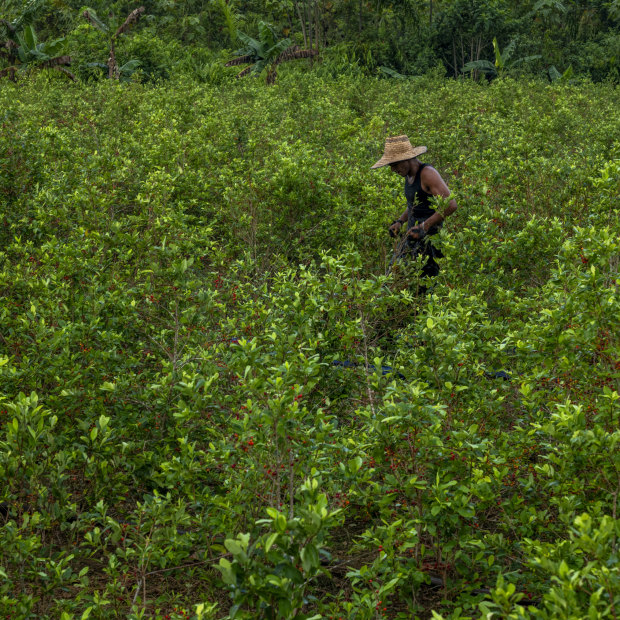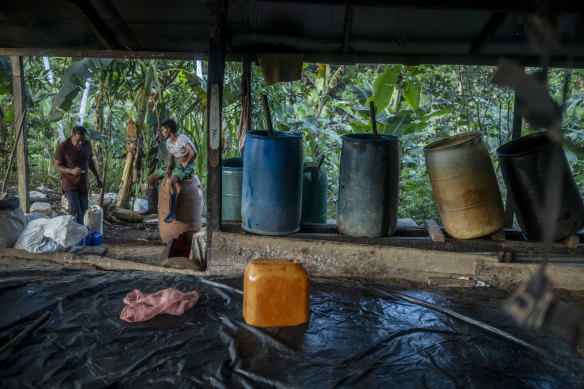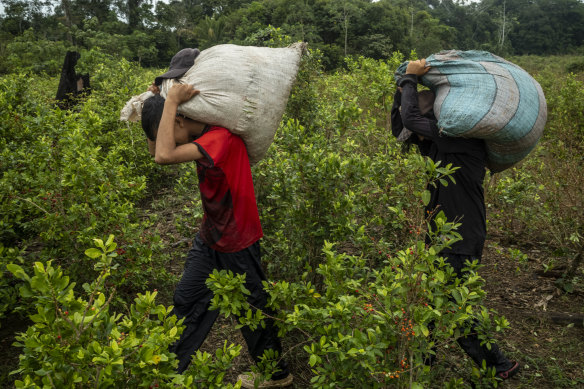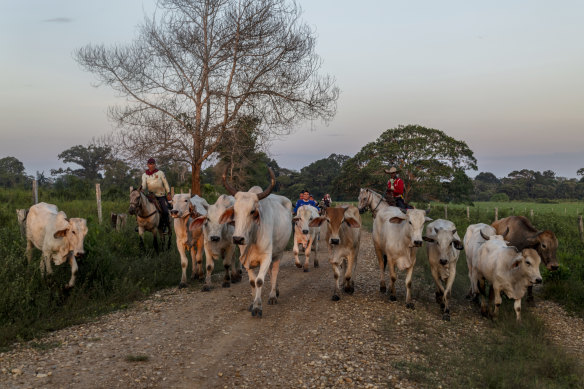For decades, one industry has sustained the small, remote Colombian village of Cano Cabra: cocaine.
Those who live in this community in the central part of the country rise early nearly every morning to pick coca leaf, scraping brittle branches, sometimes until their hands bleed. Later, they mix the leaves with petrol and other chemicals to make chalky white bricks of coca paste.

Roger Guzman harvests coca leaves in the small town of Cano Cabra, in central Colombia.Credit: The New York Times
Two years ago, the villagers said, something alarming happened: the drug traffickers who buy the coca paste and turn it into cocaine stopped showing up. Suddenly, people who were already poor had no income. Food became scarce. An exodus to other parts of Colombia in search of jobs followed. The town of 200 people shrunk to 40.
The same pattern was repeated again and again in communities across the country where coca is the only source of income.
Colombia, the global nexus of the cocaine industry, where Pablo Escobar became the world’s best known criminal, and which still produces more of the drug than any other nation, is facing tectonic shifts as a result of domestic and global forces that are reshaping the drug industry.
The changing dynamics have led to blocks of unsold coca paste piling up across Colombia. The purchase of the paste in more than half of the country’s coca-growing regions has dropped precipitously or disappeared completely, spurring a humanitarian crisis in many remote, impoverished communities.
The drug market had never seen “such a dramatic downturn,” said Felipe Tascón, an economist who has studied the illicit drug economy and had directed a national government program to help move coca farmers to legal crops.
The upending of the cocaine industry is, in part, an unintended consequence of a landmark peace deal eight years ago with the country’s largest armed group, the Revolutionary Armed Forces of Colombia, or FARC, that ended one phase of a conflict that has lasted decades.

Edilberto Linares (left) and Roger Alonso Guzman Salinas at a clandestine coca lab that turns leaves into paste.Credit: The New York Times
The leftist group financed its war largely through cocaine and relied on thousands of farmers to provide the bright green coca plant – the drug’s main ingredient.
But once the FARC exited the cocaine industry, it was replaced by smaller criminal groups pursuing a new economic model, said Leonardo Correa of the United Nations Office on Drugs and Crime: buying large quantities of coca from a smaller number of farmers and limiting their operations to border regions where it is easier to move drugs out of the country.
That means towns like Cano Cabra, deep in the country’s interior, about 265 kilometres south-east of Bogota, the capital, have seen their sole business largely vanish.
“It’s been difficult,” said Yamile Hernandez, 42, a coca farmer and mother of two teenagers who has struggled to put food on the table. “I don’t know what will happen.”
At the same time, other countries have become important competitors and have contributed to changes in Colombia’s drug market. Ecuador has emerged as a top cocaine exporter, while cultivation of coca leaf has increased in Peru and Central America.
That has helped push global cocaine production higher than it has ever been. And while cocaine consumption has flattened in the United States, it is growing in Europe and Latin America and emerging in other regions, like Asia.
In Colombia, government policies, including a move away from eradicating coca plants, and technological advances in cultivation, have allowed coca production to expand despite decades of investment by the United States to try to dismantle the cocaine industry.

Young teens Manuel and Valentina Patarroyo carry bags of harvested coca leaves.Credit: The New York Times
Annual production of the coca leaf and cocaine hit new highs in 2022, with the manufacturing of the drug rising 24 per cent from the previous year, according to the most recent data available from the United Nations.
“We’re seeing production at levels that Pablo Escobar dreamed about,” said a US official who has worked for years on drug interdiction in Colombia and asked not to be identified because he was not authorised to speak on the record.
“You go to coca fields,” he added, “and it’s like standing in a cornfield in Iowa – you can’t see the end.”
The boom in cocaine production has led to a jump in exports. Cocaine export revenues rose to $US18.2 billion ($27 billion) in 2022 from $12.4 billion in 2021, according to an analysis by Bloomberg Economics, which predicted that they would surpass oil revenues, the country’s top export, as soon as this year.
Colombian President Gustavo Petro has focused on targeting drug trafficking networks instead of eradicating the coca leaf, which has helped feed the surge in cocaine production, according to UN and US officials.
“With Petro’s disinterest in forced eradication, there are effectively no barriers to entry into the coca field,” said Kevin Whitaker, a former US ambassador to Colombia and a nonresident fellow at the Atlantic Council.
Gloria Miranda, who now directs the government’s coca substitution program, disputed this claim, noting that drug seizures had increased significantly during Petro’s nearly two years in office. Critics say that is largely because so much more cocaine is being produced.
New fertilisers have also helped make it easier to grow more coca, even as many Colombian armed groups contributing to the country’s continuing conflict are relying far less on drugs for income and turning to other illicit activities that do not draw as much scrutiny from law enforcement, like gold mining, logging and the smuggling of migrants, according to several analysts.
So while cocaine remains an enormous moneymaking enterprise for criminal networks in Colombia, the new economic model has brought suffering to many parts of the country.
At least 55 per cent of coca-growing regions in Colombia have seen coca sales plummet, Correa said.
Like many rural communities, Cano Cabra has no government presence and is controlled by an illegal armed group. There is no electricity, no running water and no public school.
Hernandez has struggled to come up with the money to send her two children to boarding school in a nearby town so that they will not have to work full-time in the coca fields like she did growing up.

Coca harvester Yamile Hernandez (left) and her teenage children, Manuel and Valentina Patarroyo, have a breakfast that serves as part-payment for work.Credit: The New York Times
The teenagers, Valentina, 16, and Manuel, 14, did work in the fields while on break from school – not for the pay, which was negligible, but for the free breakfast served by the coca farm’s owner.
Meat, a staple of the Colombian diet, has become scarce.
“All of us haven’t eaten meat for a long time because there is nowhere to buy it, and there is nothing to buy it with,” Hernandez said.
While some experts say the transformation of the cocaine industry could lead coca plant growers to transition to legal ways of making a living, many worry that farmers could instead switch to other illicit activities.
Jefferson Parrado, 39, the president of the local council that presides over the region that includes Cano Cabra, said many might switch to raising cattle – one of the world’s biggest drivers of deforestation. Other residents said that they might join armed groups out of economic desperation.

A small herd of cattle is driven along a road near Cano Cabra, Colombia,Credit: The New York Times
“Several regions have achieved economic development thanks to the coca and cocaine market,” said Diego Garcia-Devis, who manages the drug policy program at the Open Society Foundations. “What income will replace coca income? Another illegal income? Mining, trafficking of humans, wildlife, timber? Extortion?”
In many remote areas of Colombia, it is not economically viable to sell other crops because of high transportation costs. By the time produce arrived at market, it would rot, residents said. For many Colombians, the cocaine industry has been their only option.
“It does harm to humanity, and we are aware of that,” Parrado said. “But for us, it means health, it means education, it means the sustenance of the families in the regions.”
This article originally appeared in The New York Times.
Get a note directly from our foreign correspondents on what’s making headlines around the world. Sign up for the weekly What in the World newsletter here.